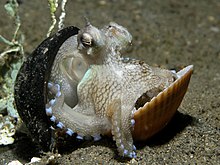Amphioctopus marginatus
| Amphioctopus marginatus | |
|---|---|

| |
| Scientific classification | |
| Domain: | Eukaryota |
| Kingdom: | Animalia |
| Phylum: | Mollusca |
| Class: | Cephalopoda |
| Order: | Octopoda |
| Family: | Octopodidae |
| Genus: | Amphioctopus |
| Species: | A. marginatus
|
| Binomial name | |
| Amphioctopus marginatus (Taki, 1964)
| |
| Synonyms | |
| |
Amphioctopus marginatus, also known as the coconut octopus and veined octopus, is a medium-sized cephalopod belonging to the genus Amphioctopus. It is found in tropical waters of the western Pacific Ocean. It commonly preys upon shrimp, crabs, and clams, and displays unusual behavior including bipedal walking and tool use (gathering coconut shells and seashells and using these for shelter).
Size and description
The main body of the octopus is normally 8 centimeters (3 in) long and including the arms, approximately 15 centimeters (6 in) long. The octopus displays a typical color pattern with dark ramified lines similar to veins, usually with a yellow siphon. The arms are usually dark in color, with contrasting white suckers. In many color displays, a lighter trapezoidal area can be seen immediately below the eye.
Behavior and habits

The coconut octopus is found on sandy bottoms in bays or lagoons. It frequently buries itself in the sand with only its eyes uncovered.[citation needed]
In March 2005, researchers at the University of California, Berkeley, published an article in Science in which A. marginatus was reported to show bipedal locomotion. It is one of only two octopus species known to display such behavior, the other species being Abdopus aculeatus. The authors discovered this behavior in an area off Sulawesi, Indonesia, where the sandy bottom was littered with coconut shells.[1] The bipedal motion appears to mimic a floating coconut.[2]
Researchers from the Melbourne Museum in Australia claimed the coconut octopus uses tools for concealment and defense by gathering available debris to create a defensive fortress. This behavior was observed in individuals in Bali and North Sulawesi in Indonesia.[3][4][5] The researchers filmed the octopus collecting coconut half-shells discarded by humans from the sea floor. They were then carried up to 20 meters (66 ft) and arranged around the body of the octopus to form a spherical hiding place similar to a clam-shell.[4][6]
See also
References
- ^ Sanders, Robert: Octopuses occasionally stroll around on two arms, UC Berkeley biologists report, University of California, Berkeley, March 24, 2005.
- ^ Christine L. Huffard, Farnis Boneka, Robert J. Full: Underwater Bipedal Locomotion by Octopuses in Disguise, Science, March 25, 2005.
- ^ Finn, Julian K.; Tregenza, Tom; Norman, Mark D. (2009), "Defensive tool use in a coconut-carrying octopus", Curr. Biol., 19 (23): R1069–R1070, doi:10.1016/j.cub.2009.10.052, PMID 20064403.
- ^ a b Gelineau, Kristen (2009-12-15). "Aussie scientists find coconut-carrying octopus". The Associated Press. Archived from the original on December 18, 2009. Retrieved 2009-12-15.
{{cite news}}: Unknown parameter|deadurl=ignored (|url-status=suggested) (help) - ^ Harmon, Katherine (2009-12-14). "A tool-wielding octopus? This invertebrate builds armor from coconut halves". Scientific American.
- ^ Henderson, Mark (2009-12-15). "Indonesia's veined octopus 'stilt walks' to collect coconut shells". Times Online. Archived from the original on August 15, 2011.
{{cite news}}: Unknown parameter|deadurl=ignored (|url-status=suggested) (help)
External links
- "CephBase: Amphioctopus marginatus". Archived from the original on 2005-08-17.
- Octopus uses coconuts - Video via EducatedEarth
- Octopus marginatus at National Center for Biotechnology Information (NCBI)
- News
